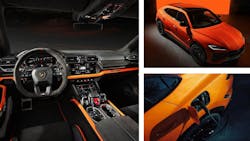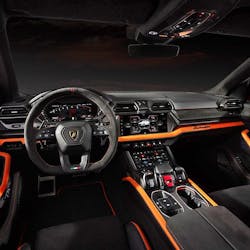Lamborghini Unveils Electric Torque Vectoring System
On April 25, the Lamborghini Urus SE, the brand’s second hybrid plug-in SUV (after the Revuelto), was introduced at the Volkswagen Group Media Night ahead of Auto China Beijing 2024.
The PHEV delivers 789 horsepower through a twin-turbo 4.0-liter V-8 and employs a single permanent-magnet synchronous electric motor with a 25.9-kWh lithium-ion battery mounted on top of an electronic rear limited slip differential. It can travel more than 60 km in EV Drive mode on all-electric four-wheel-drive power. In this driving mode, the SUV can reach a maximum speed of over 81 mph. Above this speed, the V8 engine automatically supports the electric motor.
Electric Torque Vectoring Offers Faster Response
For the first time, Lamborghini has switched from a pure mechanical, torque-based, four-wheel drive system to one that utilizes an electric torque vectoring system between the two axles, as well as an electronic rear differential. Both systems are designed and calibrated to best suit any type of road grip condition and driving style, providing maximum traction.
On a vehicle with an internal combustion engine, torque vectoring is a mechanical process. But in electric vehicles with multiple motors that independently drive each wheel, software determines how much each motor contributes.
One advantage of installing two individually controlled motors on an axle is the possibility of applying a torque differential between the two sides of the axle. A torque vectoring differential sends more power to the outside wheel to rotate it more quickly, and can slow down the inside wheel to assist in cornering. Electric motors, compared to a conventional torque vectoring differential, have faster response times in the torque transfer direction (there’s no mechanical connection between the wheels or axles).
Electronic Differential Delivers “On Demand” Oversteering
The system works in synergy with the new electronic limited-slip differential installed on the rear axle, giving the vehicle “on demand” oversteering. Oversteer happens when the car is turning and the driver applies more power than the tires can deal with. This makes the tires try to push in the opposite direction to the turn, kicking out the back end of the car.
Rather than rely on a mechanical link between the Torsen differential—a mechanical self-locking center differential that regulates the power between the front and rear axles according to demand, redirecting torque to a slipping axle—the centrally located longitudinal electric torque vectoring system in the Urus SE is actuated by an electro-hydraulic multi-plate clutch. It distributes driving torque variably and continuously between the front and rear axles.
Torsen differentials enable variable distribution of the driving torque between the axles (the word "Torsen" is made up of the words "torque" and "sensing”).
Unlike standard torque distribution, Lamborghini can now adjust torque splits as the road surface changes, and with a greater reaction speed. Having the ability to freely choose how much torque you want to, say, put to the front allows for a much more agile driving experience.
Put it all together and you have a twin-turbo V8 that can produce 611 hp at 6,000 rpm and 800 Nm of driving torque, while the electric motor adds 189 hp and 483 Nm of torque up to 5,750 rpm. As a result, the Urus SE can sprint from 0 to 100 km/hr. in just 3.4 seconds and from 0 to 200 km/hr. in 11.4 seconds, reaching a top speed of 194 mph, all according to Lamborghini.
Coming: Torque Vectoring That’s Adjustable with Paddles
In the center of the console, a selector unit is used to choose different driving modes. Six Urus driving modes are combined with four new Electric Performance Strategies (EPS) for a total of 11 options. The Strada, Sport, and Corsa modes for road and track use, and the Neve, Sabbia, and Terra modes for surfaces with a different grip than asphalt, are now accompanied by the EV Drive, Hybrid, Performance, and Recharge options.
Previously, Lamborghini unveiled the all-electric Lanzador. The two-door crossover concept is intended to become a production model in 2028 and the brand's first full EV. Expectations are that it will offer a torque vectoring system that can be adjusted on the fly by the driver via wheel-mounted paddles. This mehtod of controlling the torque vectoring on the rear axle while on the move isn’t possible in a traditional combustion-powered car.d
The Lanzador is slated for 2028 market entry.


